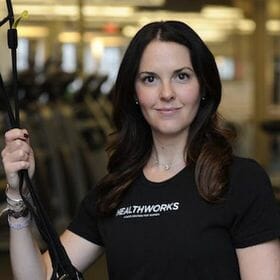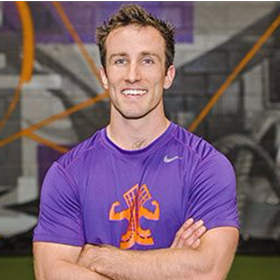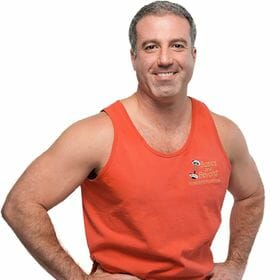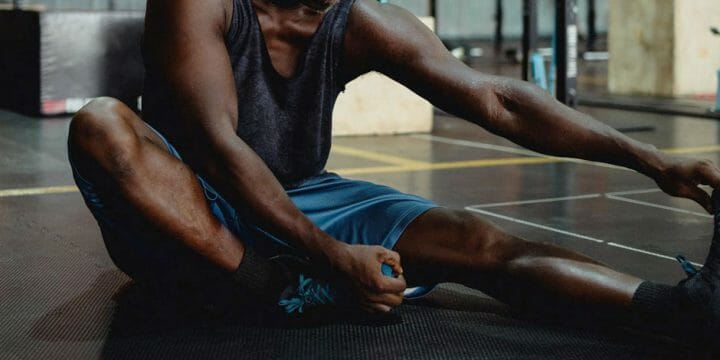Building muscles requires a lot of dedications and it takes some serious time. It’s not easy to look like Dwayne “The Rock” Johnson.
But if you follow a correct diet, train properly and do a lot of heavy lifting, you too can build some impressive muscle.
You don’t need to be a movie start or a bodybuilder or to have lots of money.
A gym membership is all you need.
To help you achieve your goal of building muscles we reached out to 28 fitness trainers and health coaches and asked them the following question:
What Is Your Best Training/Diet Tip for Building Muscle?
Without further introduction let’s see what the fitness professionals had to say.
Alex Carneiro

Best Diet Tip: The best advice everyone needs to hear when it comes to nutrition is “Know your calories”. What does that mean? It means you need to know approximately how much you are eating daily in order to lose weight or gain lean muscle.
How will you know where to go with your health and body if you don’t know where you stand right now.
No diet or nutrition program will ever be successful if you don’t know approximately how much protein, carbs, and fat you are eating, after all, you know exactly how much money you make every month right?
It’s the same for nutrition, you need to learn those numbers. A great way to approach this is by writing down or logging in on one of several many free apps your intake of food.
Best Training Tip: Switch it up! Exercise can take several forms, but after some time it can get repetitive. Find different activities to keep you motivated to want to stay in shape by challenging your mind and body to new modalities of fitness.
If you are a true gym goer and love strength and conditioning keep it as your base but start incorporating some biking, swimming or any other activity to keep your mind and body from getting bored. It’s usually when we do the same thing over and over again that we lose slowly interest in it. This also ensures your body will be having to adapt to new movements which will benefit your overall conditioning.
Related article: Myo-Reps Workout (The Ultimate Guide for Building Muscle)
Robert Herbst – W8lifterusa.com

My best training tip to build muscle is that people should allow themselves to recover from working out before training again.
You don’t get strong in the gym, you get strong outside the gym.
In the gym, you stimulate muscle growth by stressing the muscles with load, which causes microtrauma to the muscle fibers.
After the exercise, your body repairs the fibers and through supercompensation builds additional muscle in anticipation of greater loads in the future.
One must give the body the chance to complete the process. If you don’t and work out again before recovery has fully taken place, you will overtrain. Your progress will plateau and you risk injury.]
Also, you should support the recovery with proper nutrition, including protein to build muscle and carbs to fuel the recovery. You should also get enough sleep as that is when much growth occurs.
Testosterone and human growth hormone are produced during sleep and their levels are highest in the early morning. These hormones signal muscle growth to take place.
Alex Lind

Here are my top 4 tips for building muscle!
1. Weight Training within proper rep/set ranges. In order to induce muscle hypertrophy (growth), you need to work approximately 75% of the muscle. This is generally achieved by staying within the 8-10 rep range. Stick with 3-4 sets maximum.
2. Keep protein consumption high. If you are looking to build muscle, you need to consume a sufficient amount of protein. 1-2 grams of protein for every 1lbs of body weight should be sufficient. So, if you are 180lbs, you should consume approximately 180g of protein daily.
3. Support your muscles during and after workouts with proper supplementation. Make sure to take a good intra-workout and post-workout recovery drink. I feel most people only take pre-workouts and often neglect the intra-workout and post-workout drinks which are very important.
4. Avoid overtraining and make sure to get plenty of rest. Remember, your muscles need time to recover in order for them to grow. Try to get at least 48hrs of rest between Training sessions for each muscle group.
Elliott Upton – Ultimate Performance

One core principle essential for building muscle is progressive overload.
Progressive overload is the incremental increase of stress placed on the body when training.
Muscle growth comes from forcing the body to adapt to new and more challenging stressors in training.
If you do not constantly challenge the body and give it fresh stimuli to adapt to then it will never grow or improve.
Muscle grows bigger and stronger in response to the training stimulus, but for further gains, you need to continue placing further demands on the body. The progressive overload principle involves continually manipulating many strength training variables to promote hypertrophy.
Overloading the muscle requires the gradual increase of volume, intensity or frequency over time.
Simply put, this means lifting more load, doing more reps and sets, or working the muscle with more frequency or tension gradually over time.
Brian Kiselstein – Think Healthy FITNESS

There are two easy, but EFFECTIVE ways you can build muscle.
The first effective way to build muscle properly is to make sure you are calculating your macros”.
There are some complicated formulas for getting this number, this is why it is best to use a macro calculator. Next, just make sure the macros (protein, carbs, fats) you are consuming are coming from nutrient-dense foods. These foods would consist of…
|
|
The second effective way to ensure you continue to build muscle properly is to incorporate strength training.
Not just any type of strength training, you want to utilize a technique called reverse pyramid training.
“Reverse pyramid training is a technique in which you would start off your first set with the heaviest weight, and finish off your last set with the lightest weight”.
Your sets would look something this…
- Set 1: 4-6 Reps (Heaviest Weight)
- Set 2: 6-8 Reps (10% Decrease in Weight From the Previous set)
- Set 3: 8-10 Reps (10% Decrease in Weight From the Previous set)
Just make sure you warm up beforehand, and you will build muscle.
Kwame Duah – Fitness Show Brisbane

- Train with a progressive overload – Gradually increase the weight or intensity of training over a period of time.
- Eat well to recover – Eat foods that are high in protein to aid with recovery.
- Rest – Try to get at least 5 hours of deep REM sleep every day
- Train consistently – One of the best ways to build muscle is to be consistent with your training.
- Have a plan to follow – Having a training guide/plan helps take the stress of guesswork out of your training and allows you to focus on getting the job done.
- Form and technique – Your form and technique are everything when it comes to training. Having great form and technique also helps to avoid injuries.
Robert Jackson – Minimal FIT

If you want to build muscle size, understanding what “tempo” means when weight lifting is critical to your success.
Tempo refers to the speed at which you complete a movement. For example, let’s assume you are doing bench press. There are four different parts to the movement:
- Lowering the bar
- Pausing next to your chest
- Pushing the bar up
- Pausing at the top
The number of seconds you take to complete each one of those movements is the tempo.
For example, 4,1,1,0 for the bench press means you will take 4 seconds lowering the bar, 1 second pause at the bottom, 1 second pushing the bar and 0 seconds pause at the top.
Most people use the same tempo all the time, which is more like a 2,0,1,1 tempo, but to really build muscle you need to stress the muscles more so they grow.
By using a slower tempo you will increase the time under tension on the muscles for each set you do, thereby working them harder.
In addition, you will not be able to use momentum to bounce the bar off your chest. As a result, you will work the muscle through the full range of motion and not just the explosive bottom part of the movement.
You will definitely need to lighten the load vs how much you would normally lift. Put your ego aside and focus on controlled, slow tempo weight training to see massive gains.
Start off with 4,1,1,0 tempos on different exercises and then build up to 6,2,2,0. You can play around with the speed of each part of the movement.
Melissa Alcantara – Fitplan

Right now, people are obsessed with their butts, but the human body doesn’t work in isolation.
The function of the glutes is to prevent the human from falling on its face when running; they fire to keep you standing.
In addition, the butt works along the posterior chain (lower back, glutes and hamstrings) which means that the entire muscular chain needs to be addressed in training.
There’s no “one” exercise that will unlock the secrets to a functional and big ass; you need to train the system and address its strength and mobility.
Stiff muscles are actually very brittle, and your aim should be to create a butt that is both strong and flexible.
I recommend incorporating the fundamentals; squats and deadlifts. In addition, I recommend layering in hip thrusts, banded movement exercises and sprinting in order to have a nice and functional bottom. Most importantly, be patient as hell since this muscle chain takes forever to develop.
Cary Williams

For me, building muscle is extremely important to ward off pains from old injuries and to keep new injuries at bay.
Over the past 2 years, I have put on nearly 10 pounds of muscle by lifting weights properly and staying consistent.
Weekly workouts consist of 3 days dedicated to legs, 2 days where I will work on the upper body but also add in one leg exercise.
I use machines and free weights for my training and I like to do pause reps with most of my lifting.
This is where I will squeeze the muscle and pause during the contraction of the movement and then slowly release. In order to see the muscle I have been building I like to do boxing 2 days per week and add in 5-8 sets of 45-second sprints and a 15 minutes jog before I lift weights.
As for my diet, I make sure I get enough protein in, but I stay away from powders and bars. I have ulcerative colitis so I cannot consume any packaged foods for the most part and my stomach does not tolerate eggs, chicken, or salmon. I eat organic ground turkey and grass-fed organic ground beef, bone broth and grass-fed collagen powder for my protein. I mostly eat cooked spinach and carrots for my veggie source as I cannot tolerate a lot of vegetables. I also add sauerkraut to my lunch and dinner for gut health.
Remember, it is about how you lift, not how much you lift and you need to lift those weights weekly in order to see change. Building muscle takes time, so be patient!
Michael Kuang – Syphon Fitness

Building muscle depends on different factors in how you train and how you eat.
First, is to make sure you start cleaning up your diet intake and start cutting out processed foods and then find a diet that works for you.
Everyone has different dietary needs so I can’t give a blanket statement.
Once you’re ready to start weight training, I recommend starting at a level that will help you learn proper form and posture.
Otherwise, when you start lifting heavier, it is easier to get hurt and then you may not be able to progress as you’d like.
Start with a weight that is about 70% of your maximum weight, and try to do 10-12 repetitions for 2-3 sets. If that is too much, then lessen the weight and do more reps. Finding that number will be essential for success. You should feel some soreness from it the next day or two. But not to the point where it limits your ability to move.
There are also different ways to structure your workouts every week. You can split your workouts to one day doing muscles that push, then another day doing muscles that pull. You could also do upper body one day and lower body the next. Finding what feels right for you is crucial. Remember that it’s also about the amount of time the muscles are put under tension, so if you do a movement slowly, the muscles have to work harder to move.
Once you’re more comfortable with your regimen, you can start working with heavier weights and doing fewer reps with more sets.
Lastly, recovery days are important. So allow time between days to let your body recover and rebuild.
Dr. Dennis Gage – Park Avenue Endocrinology & Nutrition

It is very important for patients to understand that to build muscle and lose fat in the appropriate way you must diet slowly.
Patients who crash diet on very low-calorie diets will lose protein and fat over time this will cause a disproportionate amount of protein to be lost.
We usually recommend a combination of 1 to 2% body weight loss per week and continuous aerobic and weightlifting exercise.
Louben Repke – Repke Fitness

To train and build muscle can be easy, my advice is to actually work out and don’t get too lost in the “details.”
As a certified personal trainer, I get all sorts of questions from people looking to get in shape and build muscle.
Some questions are just so in-depth and make no difference.
Example, this week alone I had someone ask me when is the best time to eat fruit? Another client asked me when is the best time to exercise?
The answer is simple, the best time to exercise is when you’ll actually do it! If you are not a morning person then telling you to exercise in the morning makes no sense. Some people are not morning people and would never roll out of bed to exercise. So, workout at lunch or right after work if that’s when you are likely to do it.
Best time to eat fruit? There is no exact hour to eat fruit and even if there was it really would not make that much of a difference on when you eat fruit. The best time to eat it is when you are likely to such as having fruit for a snack in between meals because you find that easier.
To build muscle is similar it’s about making time to get to the gym and actually work out. Even if you don’t know how to workout, the machines are a great place to start for beginners. Just about all machines have pictures and description on how to properly perform the exercises.
My main tips are the majority of the time work out your “big muscles first” if you are working out those muscle groups on the same day then workout chest before triceps and back before biceps. Also, switch up your workouts, you do not and should not always work chest and trices or backs and biceps…switch it up.
Some days you can do chest and back, biceps and triceps, switch it up. Stick to pairing several muscle groups together for several weeks then switch up the pairs again for several groups.
Lastly, don’t do an exercise just once, so don’t just do 1 set and be done with that exercise. You should aim for a minimum of 3 sets – for me, personally, I do anywhere from 3 to 8 sets of every exercise and my repetitions vary from 6 to 15 repetitions. I start light, almost like a warmup set for the muscles then as I go heavier, I decrease the repetitions while the sets and weight increase. So days, I’ll do mainly lighter weights and do all 10 to 15 repetitions but still, I do at least 3 sets of each exercise.
At the end of the day, even if you don’t work out as I mentioned above, as long as you are consistent and make it to the gym regularly to exercise, you will get results. Be consistent, find a convenient time that you are likely to work out, cut back on greasy foods, limit refined/simple carbs but keep complex carbs in your diet.
Fruits, 100% whole grain, 100% whole wheat, vegetables etc. are a great source of good carbohydrates that you should eat. Protein is important but you also don’t need to overdo it. So, don’t buy into the hype that you need a bunch of supplements. I get the majority of my macronutrients and micronutrients from whole foods – not supplements.
Rachel Scott

Yoga (my physical exercise of choice) is about building muscle through isometric holds and slow movements.
Yoga generally builds lean muscle rather than bulking people up (think dancer rather than football player).
Choose to attend the harder classes: power, vinyasa, flow (but make sure you’ve got a teacher who can help you with alignment!).
You can get very strong in yoga, but you don’t generally get bulky.
Now, if you really want to build muscle, then a better way is to lift weights and hit the gym! But my best tip? Do something physical every day. Go for the long run rather than a short result.
Phyl London – Bodiphy

It becomes more difficult to build muscle as we age, especially after 30.
We start to lose muscle due to loss in testosterone in men and estrogen in women, the hormones that assist in muscle building and decrease the efficiency of converting amino acids into muscle.
The ability to build muscle is partly determined by genetics, however, you can always improve your body.
If you want to build muscle or decrease muscle loss experts recommend that you strength training at least 3x a week as a part of your health routine.
When beginning a strength building routine, focus on exercises that target large muscles, the larger the muscle the more opportunity to see results. I recommend always beginning an exercise routine safely by following these tips.
- Check with your physician to make sure you are cleared to start a new exercise program.
- Work with an expert, a trainer or a conditioning/health coach who can help you set reasonable and attainable fitness goals.
- Start with lighter weights and increase the amount of weight only if you can do so safely without unexplained pain or incorrect form.
- Give yourself time to adjust to the workout, at first the weight should be enough to create resistance without straining the muscles or taxing the joints and as you become stronger you can increase your range of motion and the resistance that you are lifting. (Keep in mind that The American Council on Exercise – ACE recommends that you increase the weight by no more than 5-10% to safely build resistance over time).
- Do compound move exercises that work several muscles at the same time. You’ll be able to lift heavier weights and will achieve more muscle growth. Squats, deadlifts, bench press, overhead press, and rows are all very good exercises to perform to increase your strength.
- Strength train at least 3x a week to produce enough volume to build muscle. ACE recommends performing 1 set of 8-12 reps for each exercise until fatigue, however, a trainer may have you perform multiple sets for overall health and strength.
- If you are truly dedicated to starting a strength building routine, don’t just focus on working out.
- Meet with an RD or read up on proper nutrition for successfully building muscle. Good nutrition is extremely important to help support a strength building routine. Making sure that you get enough calories from protein, carbohydrates, and fats each day will be beneficial for building lean muscle.
- You can mix cardiovascular training into your routine when trying to build muscle but don’t overdo the cardio, because it can be contradictory and decrease your strength building results and ultimately lower your metabolism.
Jaya Jaya Myra

As a woman, we have a different path to take when working to build muscle.
There’s so much misinformation out there it’s startling, so here are my top tips for building lean muscle and gaining strength.
First and foremost, eat a nutrient dense diet with adequate carbs, fats and plenty of protein. You can’t starve yourself if you want to gain muscle.
In fact, you need to be more conscious of your diet than ever.
Lean muscle mass requires the right nutrients to repair muscles, grow and build strength. If you’re not getting enough of the right nutrients and proteins, or even enough calories each day, your body won’t be able to develop the muscle mass or strength you’re hoping for.
I add a high nutrient and protein meal replacement supplement to my daily meals (note I said add, not use it to replace a meal) to ensure I have everything my body needs to succeed. (Here are some of our recommend whey protein powders)
While diet is probably #1 in terms of importance, exercise, of course, plays a huge role. I’m a fan of lean muscle, not bulky muscle, in both men or women. As a woman, I want to be extremely fit, without looking like a gym rat.
The key to this is weight bearing exercises with lower weight and more repetitions of the exercise. This also makes it easier to keep your nutrition and diet in check when you’re not taxing your body to its extremes and craving the wrong types of foods.
Once you have these first two tips in check, add on tip #3, which is consistency. Make a consistent schedule for weight-bearing exercise routine and stick with it. DO these three things and you’re well on your way to gaining lean muscle.
Brad Walker – Stretch Coach

When you think about gaining muscle, stretching is probably not the first thing that pops into your head. But did you know that stretching plays a critical role in building muscle?
Every muscle in your body is enclosed in a bag of tough connective tissue known as fascia.
Fascia is important for holding your muscles in their proper place in your body. But your fascia may also be holding back your muscle growth.
Because fascia is so tough, it doesn’t allow the muscle room to expand. It is like stuffing a large pillow into a small pillowcase.
The size of the muscle won’t change regardless of how hard you train or how well you eat because the connective tissue around your muscles is constricting the muscles within.
The solution: Stretching!
Using the pillowcase example from above, imagine you can expand the size of the pillowcase by stretching it. Suddenly, the pillow within has more room and will expand to fill that new space.
By stretching your muscles under specific conditions, you can actually stretch your fascia and give your muscles more room to grow.
The key to effective fascial stretching is the pump. The best time to stretch to expand the bags that are holding in your muscles is when your muscles are pumped up full of blood.
When your muscles are fully pumped up, they are pressing against the fascia. By stretching hard at that time, you increase that pressure on the fascia greatly, which can lead to expansion of the fascia.
Alexandra Tran – Schimiggy

When training to build muscle remember that less is more.
You do not have to train 5-6 times a week to build muscle. Having a steady 3 days per week schedule is great for building mass.
Each day I train I work on different parts of my body and I leave one day to do active recovery OR just fully rest.
Active recovery for me includes yoga classes such as vinyasa or hatha or light hiking with my dog.
I also recommend taking protein (I take Orgain) after every workout to improve your muscle recovery and growth
If you don’t like protein, make sure your diet consists of healthy meats such as fish and chicken and omit salts and too much seasoning. Eating healthy is a great way to build lean muscle.
Allison Jackson Fitness

When it comes to building muscle, the best training and diet tip I can offer is to lift heavy and eat an adequate amount of protein and carbohydrates before and after your workouts. People are afraid of getting bulky from weight training.
But the truth is that it takes an extraordinary effort to gain muscle unless you’re a newbie lifter.
Incorporate a variety of compound exercises like squats, deadlifts, bench presses, and shoulder presses, and be sure the weight you use is challenging.
And by challenging, that means you should struggle to get through the last few reps.
When it comes to your diet, you’ll want to eat 20-30 grams of protein and 20-30 grams of carbohydrates before and after your workouts. This will give you the energy to tackle a tough workout and refuel your muscles after you’re done.
Some good options are protein shakes with banana or hard-boiled eggs with rice cakes. In addition, be sure to get enough protein throughout the day. Getting 20-30 grams of lean protein at every meal should do the trick.
Jason Priest – Dad Bod Health

My best training and diet tip for building muscle is a multifaceted approach. There are two main components when it comes to building muscle and they are both equally important.
First, a person must perform heavy weight training on a consistent basis in order to break down muscle tissue and prepare the body for muscle growth.
I suggest lifting heavy weights and doing 3 sets for each exercise and staying in a rep range of 8-12.
This allows for adequate muscle tissue to be broken down which is the first step in adding lean muscle mass. For most people, this is generally the easier part.
Secondly, a person must consume enough calories as well as enough protein to support lean muscle growth. This is often where people struggle. The number of calories needed to add lean muscle mass with any regularity can be quite challenging for some people to stick to.
But in order to get results from the hard work being put in during heavy weight training, it is imperative that the body gets proper nutrition in order to fuel lean muscle mass growth. This can be a lengthy process and I cannot overemphasize the importance of consistency.
The bottom line when it comes to building muscle is you must fuel your body with the proper nutrients in order to support muscle growth while staying consistent with a heavy weight training plan.
Check out our best supplement stack for muscle building article.
Morgan Balavage – Splendid Yoga

To build muscle, lift heavy.
The more load you put on your body, the sooner your body will get the message, “Hey brain, we need more muscle here!”
It’s worth it to hire a physical therapist for one session to ensure your form is correct).
Increase the weight you’re lifting by 10% each week.
Adam Kemp Fitness

I am 6’ 10” and because of the length of my legs and arms it has always been difficult to add muscle mass.
However, German Volume Training is a workout routine that I have used every off-season for years to help me build a few extra pounds of muscle before my next season.
The workout routine is simple, brutal, and effective.
German Volume Training involves 10 sets of 10 reps, with only 1-minute of rest in-between.
For this exercise, you should use compound exercises like the bench press, overhead press, or similar. I have done German Volume Training with both back squats and deadlifts before, and they are very effective if you have good form for these exercises.
Doing a proper German Volume Training Routine for 6-8 months is a great way to shock your muscles, blast through any training plateaus, and build lean muscle mass in a short amount of time.
I also suggest you eat as much as possible while doing this routine, because your basal metabolic rate will rapidly increase from the training stimulus.
Marshall Weber – Jack City Fitness

Building muscles relies on using the right type of exercises, eating healthy and ensuring there’s adequate protein in your diet.
It starts by getting stronger and using compound exercises rather than isolating specific muscle groups. The more you lift, the stronger you become and strength equals more muscle mass.
Add more weight to your routine rather than adding reps. When you do compound exercises, you’ll work several different muscle groups at the same time.
Compound exercises include squats, bench, overhead presses, deadlifts and barbell rows. The more weight you lift, the bigger your muscles grow.
Always start light and make sure you have the proper form to get the best results and avoid injury. Don’t forget to do strength building more than just once a week. Don’t forget about muscle recovery either. They need to rest a day to repair the damage, which makes them grow bigger. In fact, if you workout hard daily, you’ll actually sabotage your efforts and could end up sick.
Boost your recovery efforts with rest and healthy eating. Finally, improve your eating habits. You need to eat more if you’re working hard and increase your protein intake for post workout meals. It helps repair damaged tissue and build new tissue. You need a gram of protein for every pound you weigh on the average if you’re working intensely to build muscle tissue.
Stay consistent with your workouts and healthy eating and you should get the results you want, but it will take a while. The form is everything when you’re working out, especially if you’re going heavier. To avoid injury and get the maximum from your exercise program, make sure your form is right. Most importantly, don’t forget to stretch!
Lauren Lobert – APEX Physical Therapy

My tips are as follows:
1. Eat enough calories!
You need to eat enough calories to support muscle growth. Recomposition is possible, where you decrease fat and increase muscle, but you are eating a very slight caloric deficit at that point (maybe a couple hundred calories).
Bottom line is you need to eat enough to support gaining muscle. Protein recommendations are 2.0-2.5 g/kg of lean mass for young men who are experienced lifters.
2. Progressive overload!
This means you need to continue to challenge yourself in order to see changes in your body. Whether it’s more repetitions, more weight, or more sets you need to continuously progress your training. This is challenging because it requires planning your training ahead of time.
You can’t successfully progressively overload if you are constantly changing exercises or have no idea what number of sets, reps or weights you did last time.
Ashlee Van Buskirk – Whole Intent

Muscle development also depends heavily on the types of exercises you do and your recovery times.
Many people believe you have to workout every day to build bigger muscles, but that’s not actually true.
You build muscle by tearing down your muscle fibers through exercise and the recovery time is where the muscle grows.
If you tear your muscles every day, you’re not giving them enough time to rebuild and heal. Remember to space out your workouts for more time to recover.
Anyone trying to build muscle needs to remember to focus on their positive energy balance. This balance refers to the balance of energy you take in and the energy you put out. Ideally, you want to be consuming more caloric energy than you’re exerting.
Many diets recommend cutting out carbohydrates to limit your caloric intake, but those carbs and calories are important to sustain your energy. A negative energy balance (more out than in) isn’t a good starting point for building muscle.
It’s also unwise to bulk up with excess carbs and calories, only to lose that weight in a short amount of time. Any fast fluctuations in your mass has ripple effects on your health, so it’s a good idea to just skip over the bulking up fad.
Your diet should focus on nutrient-dense foods, such as avocados, nuts, peanut butter, fish and so on. While protein is very important for building muscle, you have to supply yourself with other essential vitamins and minerals for healthy muscle development. And, those essentials are integral to your positive energy balance as well. So, don’t skip over them either!
Amanda Kostro Miller – Smart Healthy Living

Even though protein is important for building muscle, your body needs a well-rounded diet to be at its peak.
Aside from potential kidney issues and/or possible dehydration from excessive protein intake, if you are eating more protein than you need, your body will excrete it, use it for energy or store it as fat.
You don’t want excess calories and fat collecting over those nice bulging muscles, right?
So, strive to get enough protein for your needs and fill your plate with fruits, veggies, whole grains and healthy fats as well.
There are specific protein recommendations to follow. The first step to figuring out how much protein you need is to know your weight in kilograms. To figure out kilograms, take your weight and divide it by 2.2. For example, a 200-lb person would divide their weight by 2.2 and get 90.9kg. Once you know your weight in kilograms, use this protein guide:
The average healthy adult needs 0.8 grams of protein per kilogram body weight. So, a 90.9-kg person would need about 72.7 grams of protein per day. If you are athletic, that number jumps up to 1.2-2 grams of protein per kilogram body weight since you are exercising a lot and working your muscles!
Dan DeFigio – Basics and Beyond

Here are two nutrition tips:
1. One of the little-known powerhouse supplements for building muscle and improving your recovery is OKG. Ornithine alpha-ketoglutarate (if you want to use the fancy-pants scientific term) decreases muscle protein catabolism and increases the synthesis of anabolic metabolites.
It works so well because it contains the carbon skeleton of glutamine (which helps with both muscle growth and recovery, and boosting your immune system), but does not result in the ammonia byproduct like pure glutamine does.
So you get all the benefits of glutamine supplementation without the generation of excess ammonia that puts a burden on your muscular recovery.
2. For optimum muscular growth and recovery after your workouts: If your workouts are intense, your ideal post-workout nutrition will consist of 25% of your daily protein combined with 4 times as many carbs.
Post-workout is the ideal time to infuse your depleted muscles with amino acids, creatine, and carbohydrate fuel, so this is the best time to use high-glycemic carbohydrates (like fruit juice or maltodextrin-based shakes) to maximize cellular uptake. (Here are our favorite creatine supplements)
If you need a cookie fix, right after your workout is the ideal time! Post-workout is also the ideal time for additional branched-chain amino acids or OKG. You have about a 30-minute window to take advantage of the additional uptake potential following a hard muscle-shredding workout.
Jennifer Hanes – Dietitian Jenn

We’ve all heard of eating protein after a work-out. However, it may be equally, or more, important to spread your protein out throughout the day.
Your body only utilizes a finite amount of protein (about 25-30 g) at one time.
To help your body best use your protein, go ahead and eat some protein after your work out.
However, make sure to also include protein in all meals and snacks to really make sure you get the protein your muscles need to grow.
This means your breakfast of just oatmeal or fruit and toast may not be adequate. Add an egg or 2 to breakfast, add some nuts or low-fat cheese to your afternoon apple. Just don’t go overboard, or you may accidentally eat too many calories.
Christine Cronau

By far my best tip for building muscle is to eat keto. As a nutritionist, I find the keto diet assists with muscle growth even in those who are unable to exercise.
And. of course, adding exercise to the mix gives even better results.
How does this work? Carbs are not necessary for muscle growth, protein and fat are more nutrient dense than carbohydrate, and quality protein, in particular, is essential for muscle growth.
Eat fewer carbs, and you will get more of what you need to build muscle.
And, going keto allows the body to burn fat for energy and store less fat, which means you are more likely to see the muscle you are building!
Thank you so much to all the fitness trainers that participated in this expert roundup!
If you wanna learn more about health and fitness, check out our website, Total Shape, where we share the best resources on muscle building, weight loss, and everything else in between.
Related Articles:
About The Author
You May Also Like






